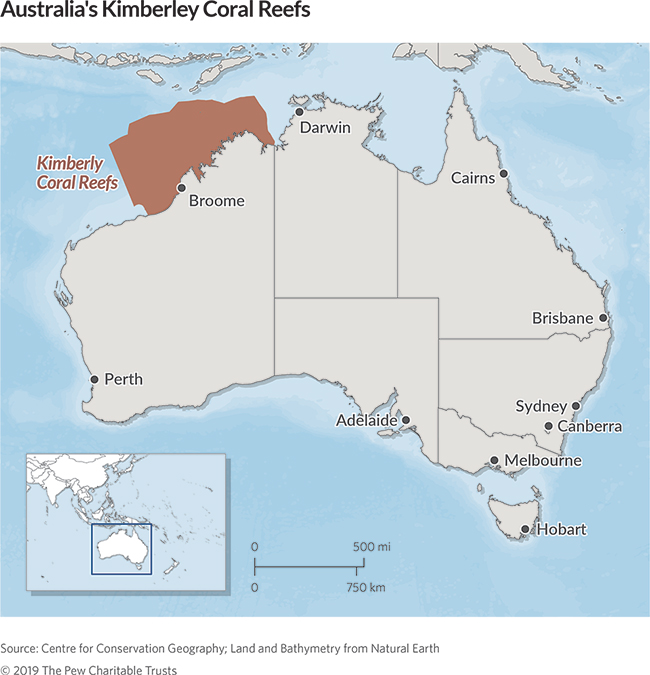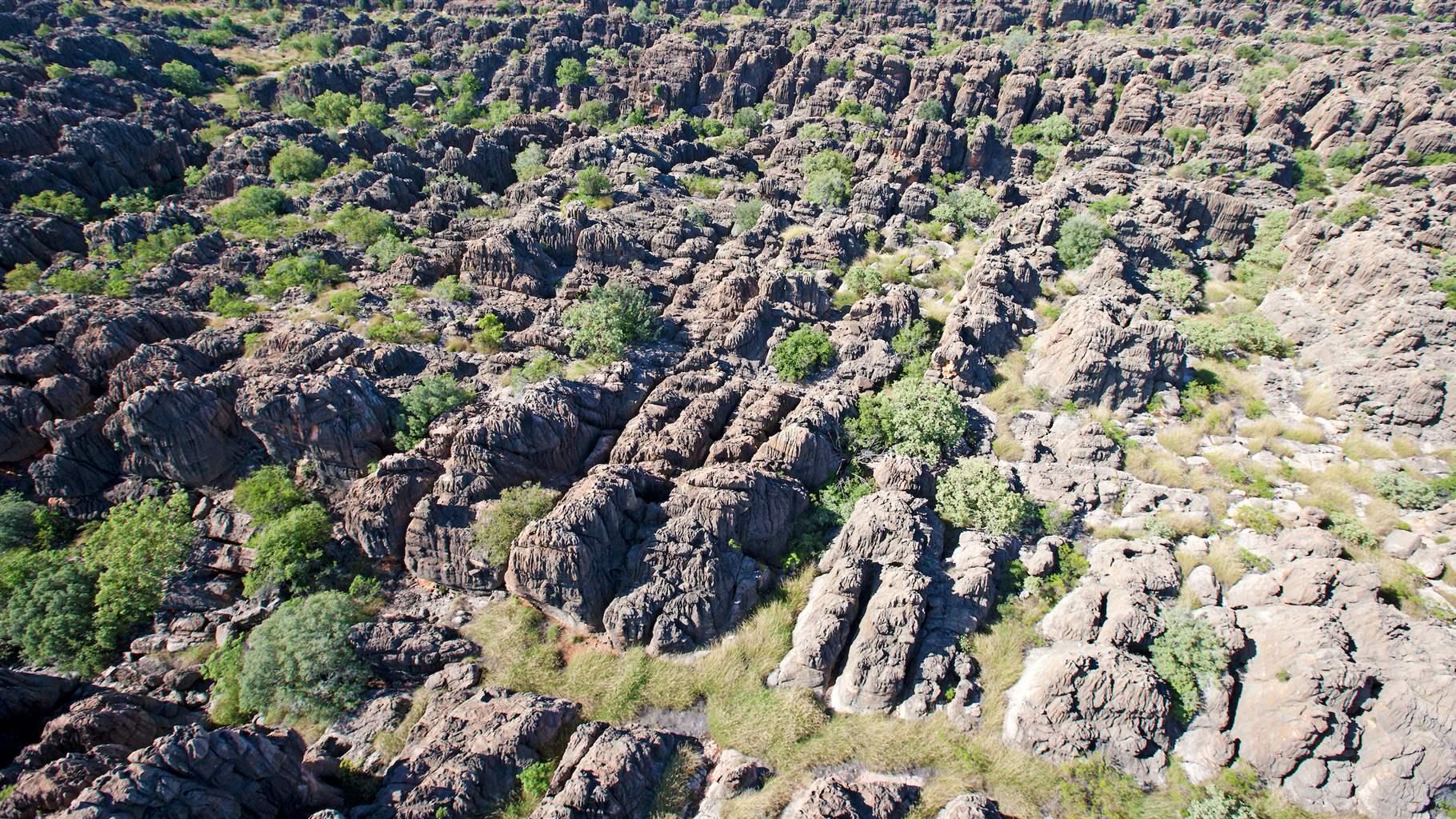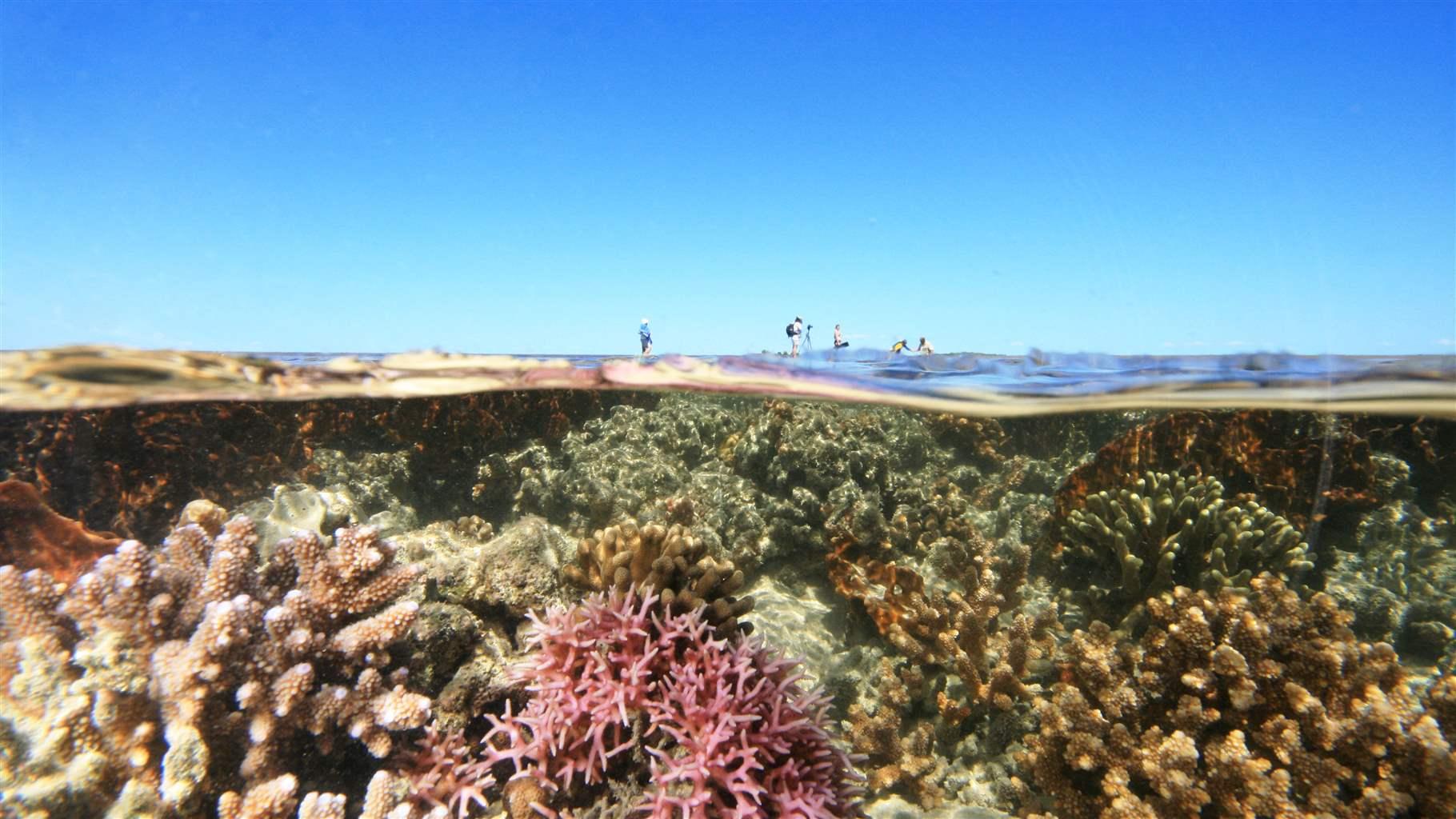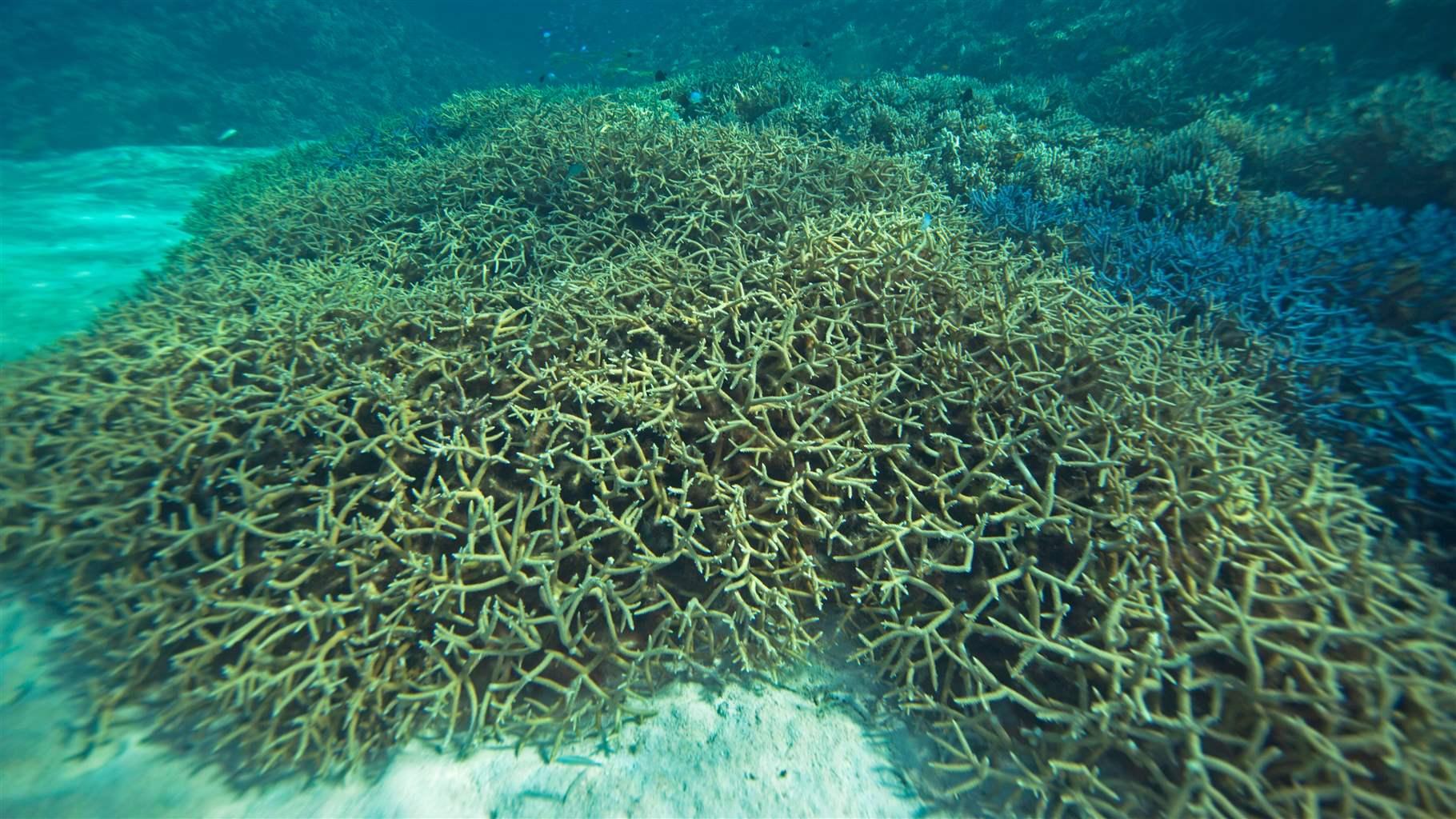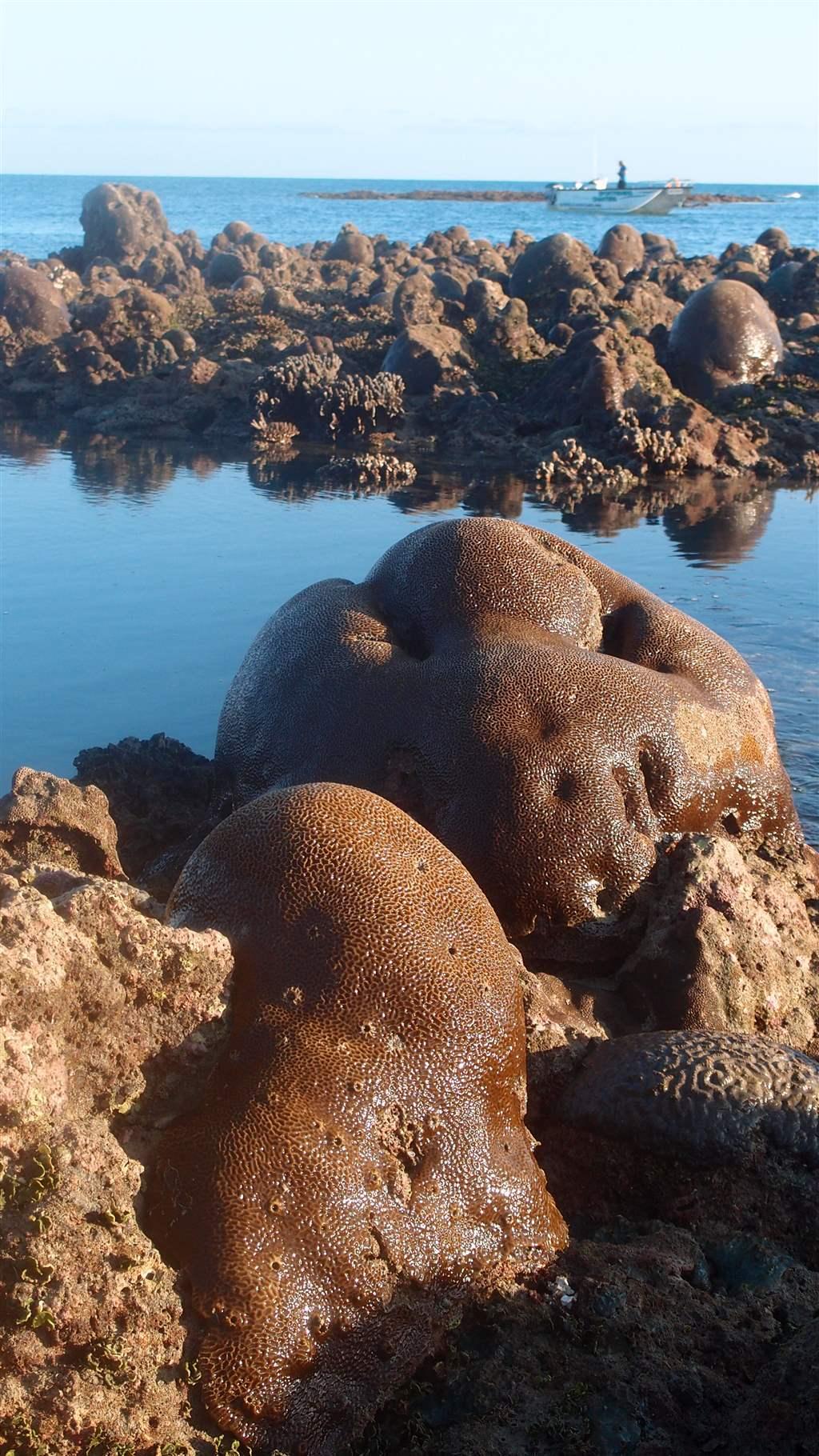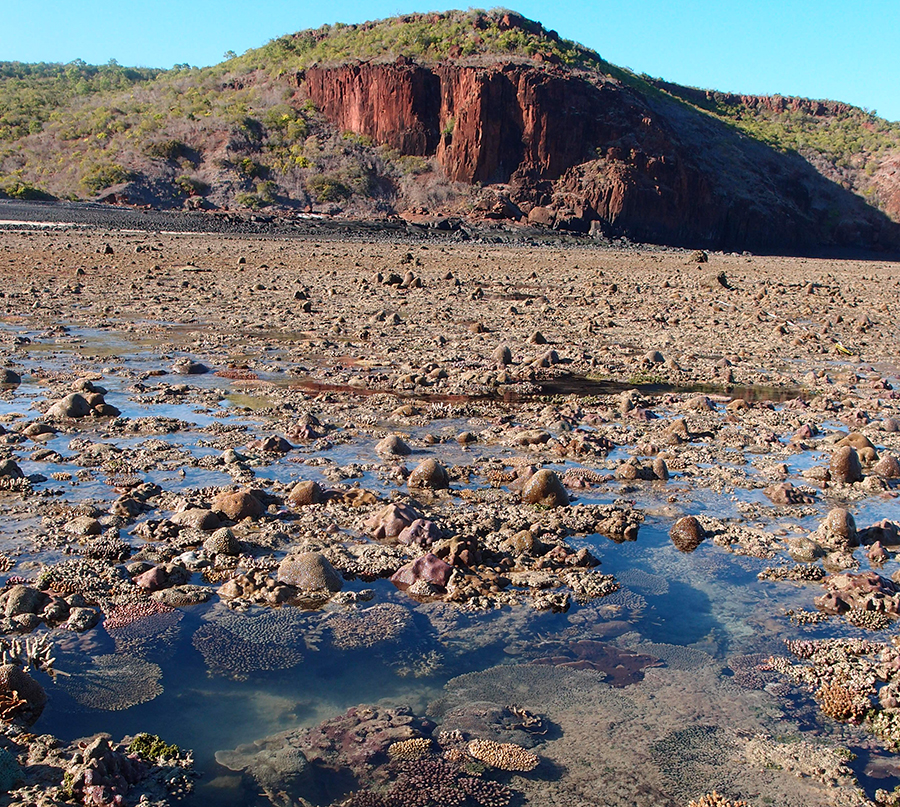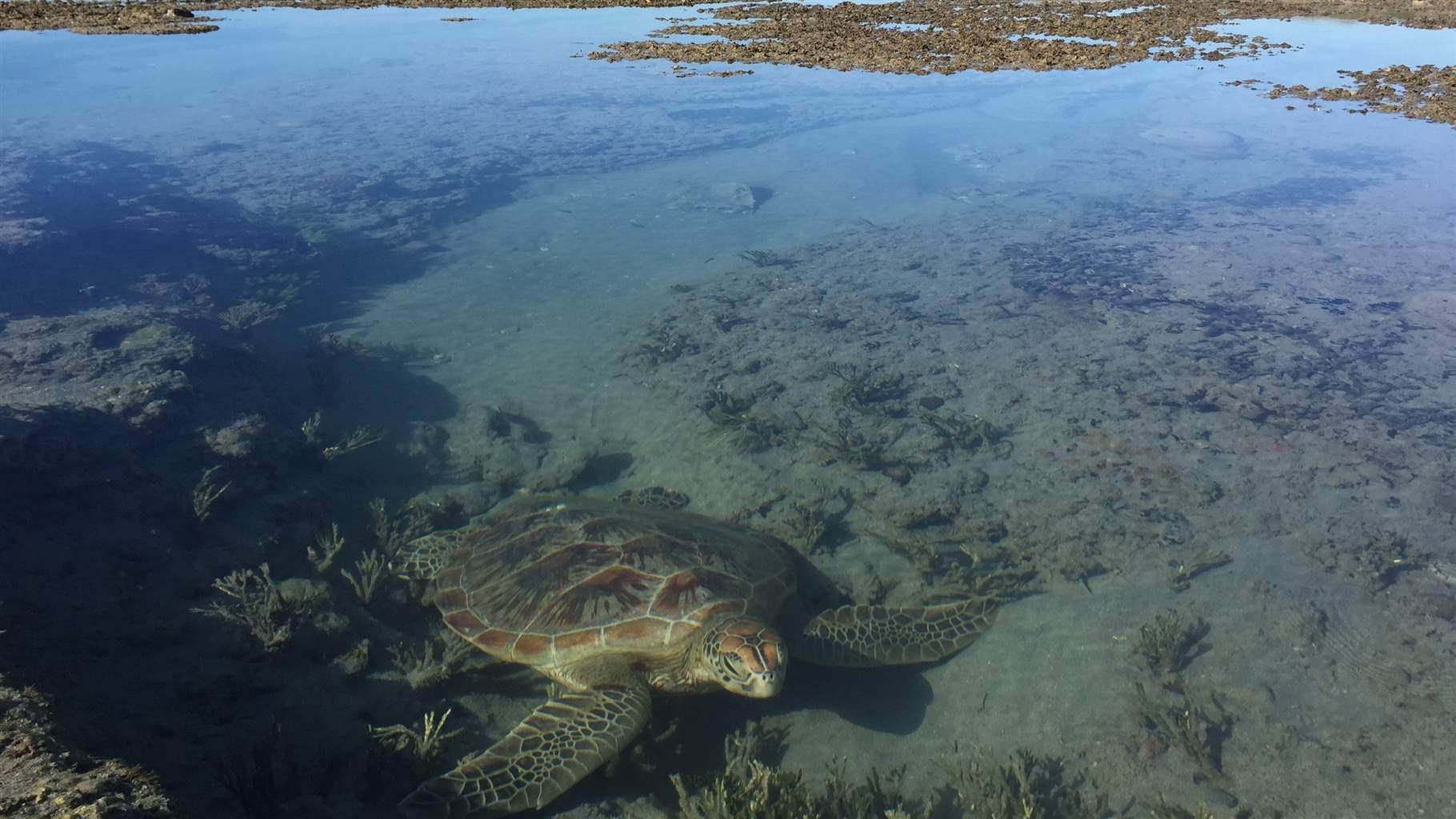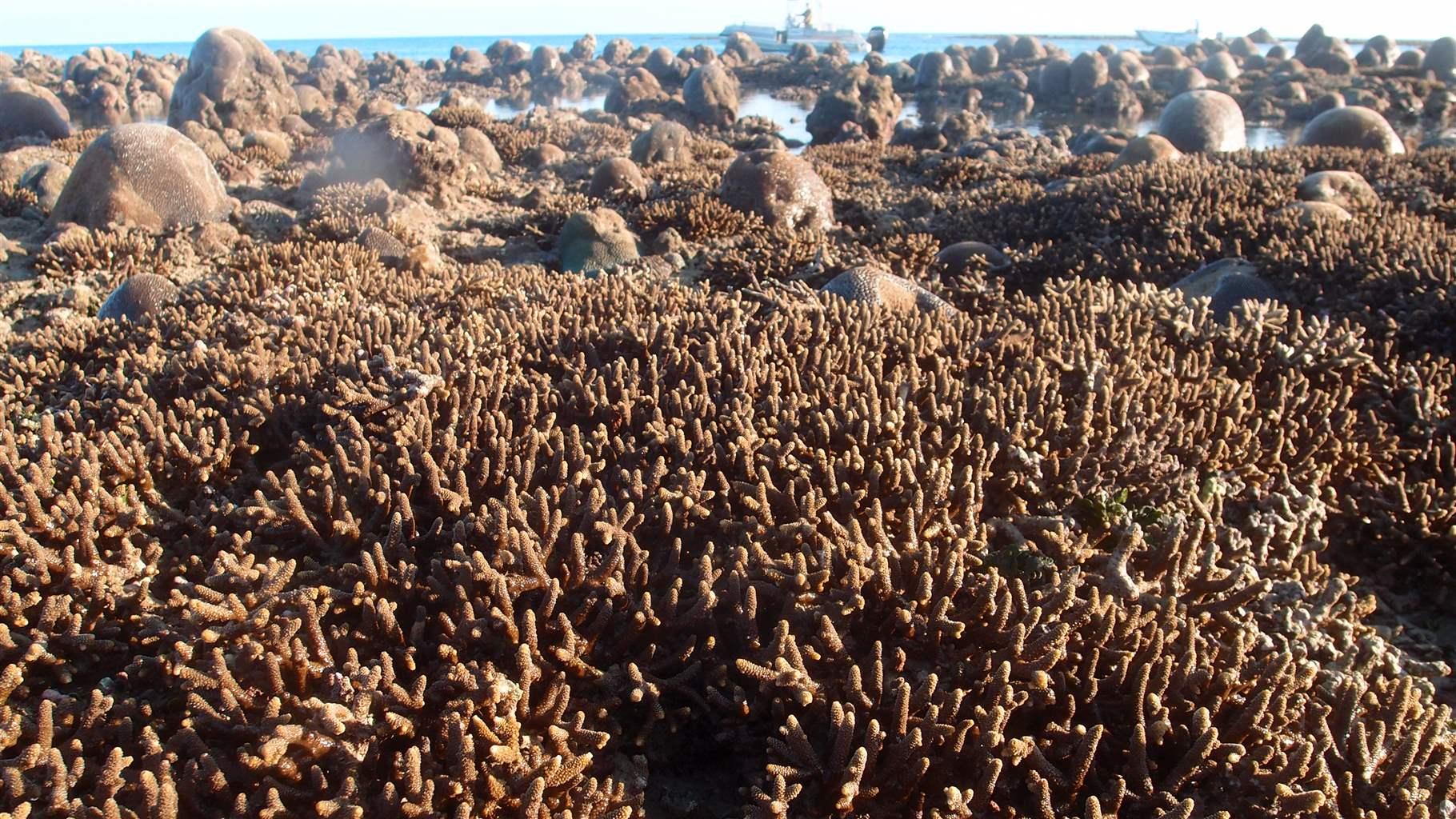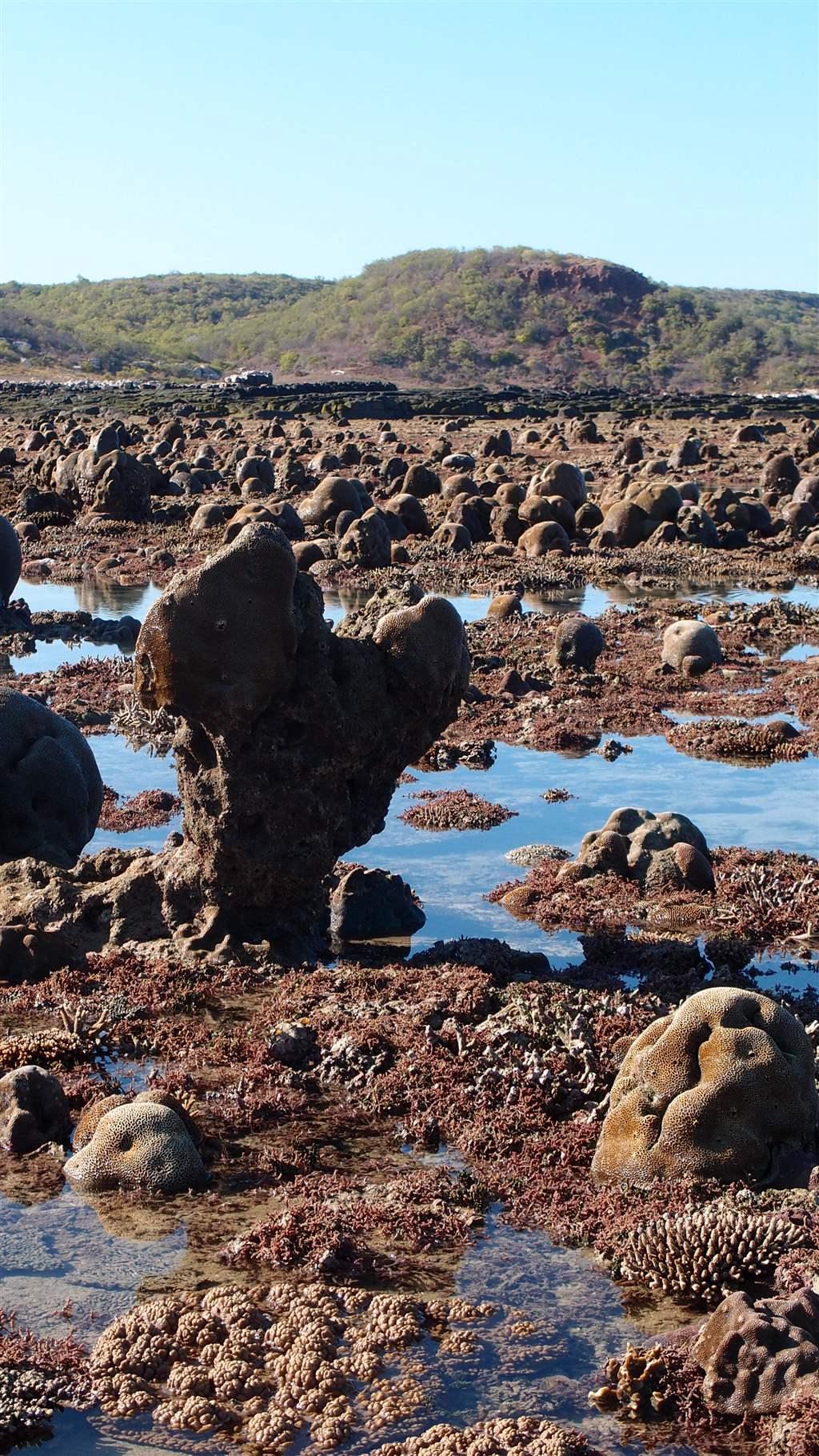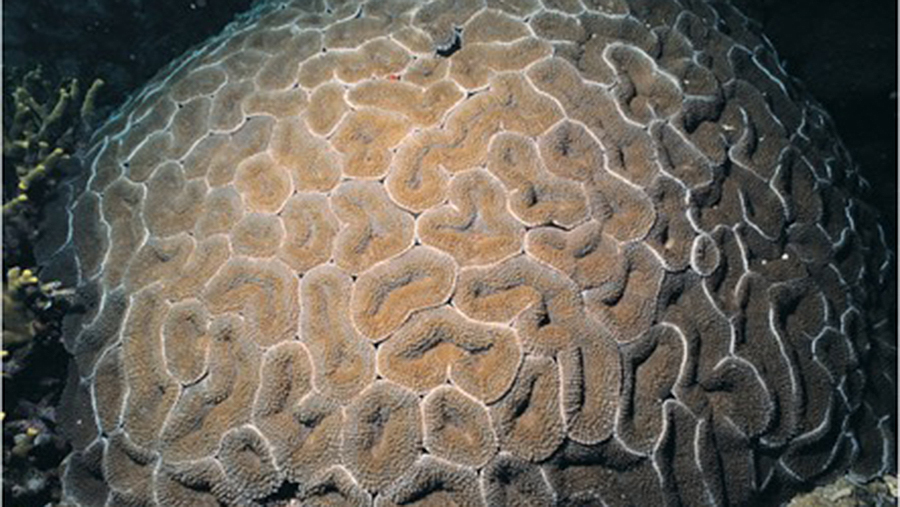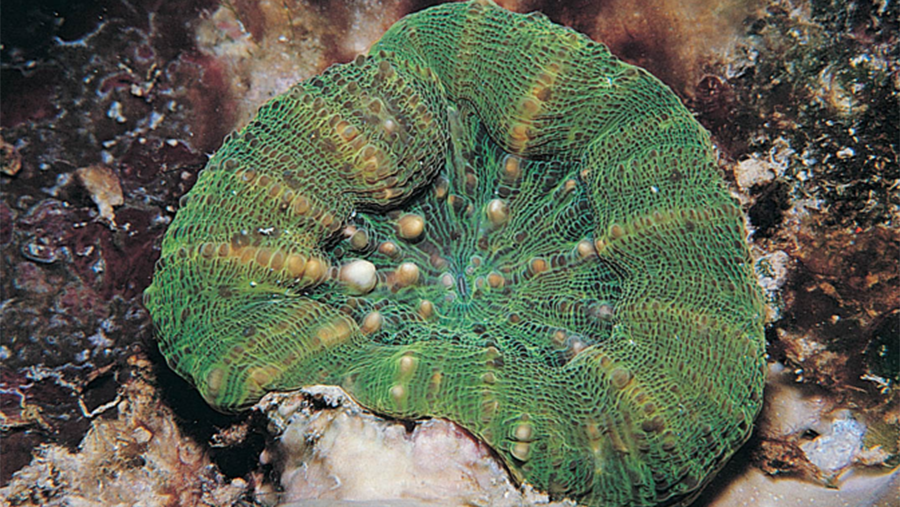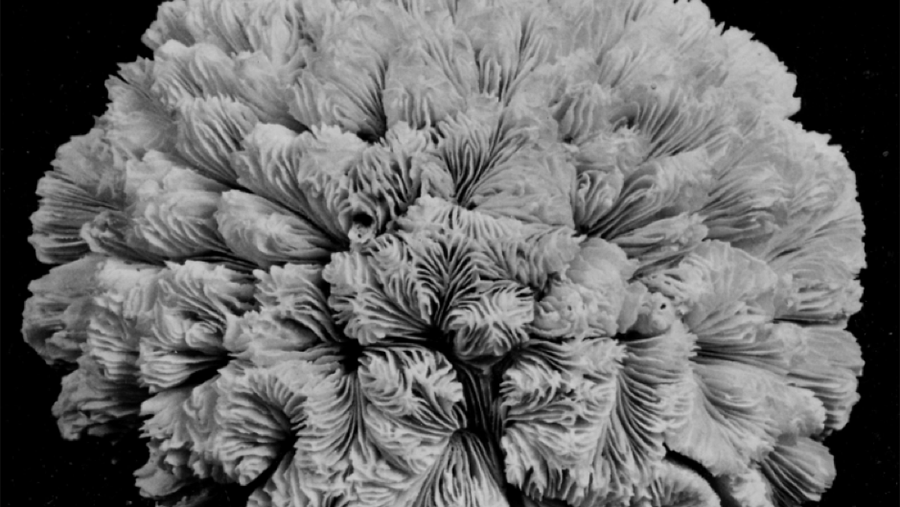Coral Reefs in the Kimberley Adapt to Survive
New research shows surprising durability in a harsh environment, but also a need for protections
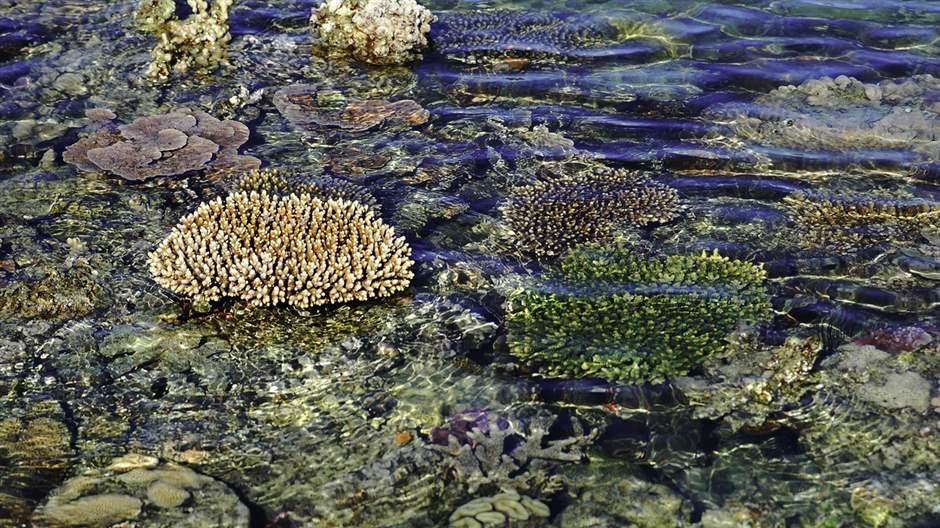
Overview
As our planet has become more developed it has become increasingly difficult to catch a glimpse of its ancient past. One special place where time has seemingly stopped, and primordial red cliffs plunge into tropical waters teeming with life, is the Kimberley region in the northwestern part of Australia (Figure 1). The Kimberley’s vast coastline extends northeast from Eighty Mile Beach to the border of the Northern Territory, and its tropical waters stretch 200 kilometres (125 miles) west into the Indian Ocean. The relatively pristine nature of the Kimberley is rivalled only by places such as the remote reaches of the Arctic and Antarctica.
This unscathed region harbors some of the world’s most unusual and resilient coral reefs—the most diverse in Western Australia, with some boasting greater diversity than the famed corals of the Great Barrier Reef. The Kimberley’s complex rocky coastline, over 2,000 islands, and deep oceanic shoals shelter huge swathes of fringing coral reefs and remote coral atolls on the edge of the continental shelf.
Corals here have adapted to thrive in extreme environmental conditions, including high temperatures, wind and sun exposure, making them some of the most robust and resilient coral communities known to science.
The remote Kimberley coast is also one of the world’s least studied tropical marine environments, owing to logistical barriers such as 12-metre (40-foot) tides, uncharted reefs, strong currents and dangerous box jellyfish and saltwater crocodiles. Despite these challenges, recent investment in research is beginning to paint a clearer picture of the special adaptations and extraordinary marine biodiversity found here, all of which need protecting. Each expedition unearths new species and unravels longstanding mysteries.
Key findings from the research include:
- The Kimberley coast is home to some 400 species of coral, including coral aggregations seen nowhere else.
- Some corals grow differently here than in any other place on Earth.
- The coasts are one of the world’s last refuges for endemic, rare and endangered species such as humpback whales, sea turtles, invertebrate life and fish.
The very remoteness that has traditionally made the Kimberley difficult to study has also made commercial exploitation of the area difficult—which has served to protect the reefs.
But remoteness alone cannot be relied on to protect the Kimberley’s corals forever. Pressure from tourism and mining interests is increasing, making it imperative that the region be protected before it becomes damaged beyond repair.
Today it is critical that research continues throughout this area, and that the resulting scientific findings are then used to help the Australian Government understand the best ways to protect the Kimberley’s unique coral reefs within a world-class network of no-take marine sanctuaries.
An ancient seascape
The Kimberley is home to Australia’s earliest barrier reef system which, over 350 million years ago, harboured an array of marine life. The Devonian Reef complexes, containing some of the most impressive fish fossil deposits in the world, now sit high and dry over 300 kilometres (186 miles) inland, forming a belt of impressive limestone ranges.1
The region’s modern offshore reefs are thought to have begun forming around 15 million years ago; they have developed through the ongoing movement of the continental shelf and their range continues to grow with the rise and fall of sea levels.2
In contrast, today’s living fringing and mid-shelf coral reefs are much younger, with the earliest coral growth on the Kimberley’s inner shelf starting around 120,000 years ago.3 These reefs began when the Kimberley plateau’s 2 billion-year-old protozoic rock platform was dissected by terrestrial erosion, which created deep valleys. Today’s coastline was formed through the inundation of these valleys following global sea level rise about 6,500 years ago.4 During this inundation period, the Kimberley coast was invaded by some pioneer coral species that travelled down from the Coral Triangle. These interlopers were highly adaptable and tolerant to extreme conditions, making it possible for them to settle and grow into the thriving coral communities we see today.
Recent research has found that the corals have had three major growth spurts over geological time.
Their high tolerance for challenging conditions, and ability to adapt to them, has meant the Kimberley’s coastal coral reef communities have thrived in environmental conditions that were previously thought almost impossible for corals to survive in.
A harsh environment
Murky waters
With a tropical monsoonal climate, the wet season in the Kimberley (November-March) can see up to 1,500 millimetres (59 inches) of rainfall, with numerous rivers draining into the coastal environment.
The flood of sediment-filled freshwater inshore means the region has an unusually high turbidity. This murkiness poses a real challenge for corals as many rely on sunlight to fuel the photosynthetic activity of zooxanthellae, microscopic algae living within the coral polyp, for food. Without this light source, many corals would not survive.5
However, many corals in the Kimberley have evolved to find another critical source of energy, filter feeding. Most scleractinian (hard coral) species can absorb some energy through heterotrophy, or filtering organic particles in the water column. Heterotrophy is one of the secrets to success in these highly turbid waters that are full of nutrients and, coupled with active waters, there is a constant fresh supply. Kimberley corals have evolved an enhanced ability to gain energy in this way, which helps explain the surprising success of coral reefs in such a highly turbid coastal environment.6
Another challenge faced by fragile coral polyps is the risk of smothering due to settlement of suspended particles in the water column. Corals have adapted to deal with this issue in a number of ways, with some actively removing the sediment with their tentacles and others excreting a protective layer of mucus.7 Several coral families have also adapted a clever morphology that helps to prevent these suffocating particles from settling. Each of these strategies requires a lot of energy. Additionally, high sedimentation rates usually lead to poor coral health. However, the corals of the Kimberley are some of the world’s healthiest.
The need to adapt has led to the astonishing diversity of the Kimberley’s fringing coral reefs, which have over 60 types of corals found only in highly turbid environments.8
High and dry
Spring tides of up to 11 metres (36 feet) flood over the Kimberley’s extensive tidal flats, making them one of the largest intertidal environments in the world.9 In fact, the Kimberley’s tidal range, the only known place where corals survive such huge tides, is beaten only by the Bay of Fundy in Canada.
Many of the platform reefs sit above mean sea level, meaning that on a falling tide they appear to rise from the ocean.10 Montgomery Reef, 20 kilometres (12 miles) off the central Kimberley coast, is one of the most spectacular places to see this phenomenon. On a spring tide, the reef appears almost 5 metres (16 feet) above the surface as water cascades down its many channels and passes.
With such large tides, some of the Kimberley’s intertidal reefs can remain exposed at low tide for over three hours. During this prolonged period, they can be subject to potentially damaging levels of UV light and extremely high temperatures, yet the hardy Kimberley corals survive.11
At low tide most of the reefs hold on to some water in intertidal pools, which create a challenging and dynamic environment. Despite the water becoming a stagnant, low-oxygen environment in these pools with temperatures reaching up to 40 degrees Celsius, conditions that usually cause extreme stress for coral species, healthy corals are still found there.12
The massive tides also mean there is a huge amount of water movement at speeds of up to 12 knots along the Kimberley coast. One of the most famous sites is Horizontal Falls, where huge volumes of tidal water rush through a narrow gorge. Regardless of this powerful movement of water, which scours the seabed and reduces visibility to zero, some tough coral species have been found growing on the walls.
The huge tides do have some benefits: their daily flood of clear, cooler water provides some respite from the murkiness and gives the coral reefs some breathing room to photosynthesise.
Extreme temperatures
Corals are the Goldilocks of the ocean: Their environment can’t be too hot or too cold; it must be just right. Most corals grow in water temperatures between 23 degrees and 29 degrees Celsius and the thermal stress associated with just a 1 degree increase above normal can cause corals to bleach.
Bleaching occurs when a coral gets stressed due to higher than normal temperatures and expels the brightly coloured zooxanthellae it relies upon for most of its food. Without the zooxanthellae, the coral skeleton appears bright white and the polyp begins to starve. If the stress is only for a short time, the corals can recover. However, thermal stress that continues for a prolonged period (more than three days) can lead to widespread mortality and it can take many years for the reef to bounce back.
Coastal Kimberley corals thrive in temperatures more extreme than almost all other coral habitats. They are exposed to annual temperature variations from 22 degrees to over 31 degrees Celsius, with temperatures often exceeding 30 degrees for some five months of the year.
Research has found that while Kimberley corals remain susceptible to bleaching from extreme elevated temperatures, their bleaching threshold of around 32 degrees Celsius is significantly higher than that of typical coral reefs, which tend to show signs of stress in prolonged periods of temperatures over 29 degrees Celsius.13
A study of the intertidal reefs in the Bonaparte Archipelago found these corals survived an eight-day period of elevated sea surface temperatures well beyond the 1 degree Celsius bleaching threshold usually leading to high levels of mortality.14 And in 2010-11, when over 2,000 kilometres (1,200 miles) of the West Australian coastline experienced extensive coral bleaching and widespread mortality, the inshore Kimberley reefs showed no evidence of having experienced the same extensive bleaching.15
In 2016 the most extreme El Niño event ever recorded caused a huge spike in ocean temperatures, leading to the devastation of many of the world’s coral reefs and the first time widespread coral bleaching was documented on the Kimberley’s fringing reefs. There is hope that due to their enhanced ability to take in organic matter for food, Kimberley corals may be able to recover better than other reefs. However, only time will tell.
While minor in comparison to the widespread mortality that occurred on the Great Barrier Reef, this bleaching serves as a warning that in a rapidly warming world, even the corals of the Kimberley, which have adapted to survive in conditions where few reefs can, are at risk.
Wild and windy
The Northwest coast is the most cyclone-prone area in Australia and among the most cyclone-affected areas in the world.16 Since 1965, 49 tropical cyclones have passed through the Northwest.
Cyclones can have a devastating impact on fragile coral reef systems through huge waves that smash coral skeletons, unusually low tides that leave reefs exposed longer than they are accustomed to, higher than normal turbidity and a large influx of freshwater.17 Branching coral communities are the most susceptible to catastrophic cyclone damage, yet are some of the most abundant and dominant corals found among the Kimberley’s fringing reefs.18
The ebb and flow of long-term sea levels, in addition to the highly turbid, macrotidal conditions and fluctuating temperatures in coastal areas, have made the Kimberley reefs highly complex with rich coral-dominated diversity.
Diversity in many forms
The coral reefs of the Kimberley are different from reef structures found elsewhere, and can be split into three unique types: the intertidal rocky shore, coastal fringing reefs and the offshore platform reefs and atolls.
Intertidal rocky shore
The intertidal zone of the Kimberley’s rocky shore is dominated by diverse coralline algae communities. It is also home to a sparse scattering of non-reef-forming colonies of faviid and poritid types of coral growing directly on rock platforms often exposed at extreme low tides.19 With biologically distinct zones relative to levels of exposure, the rocky shores are also inhabited by numerous bivalves, colonial ascidians (primitive sea slugs) and encrusting sponges.20
Coastal fringing reefs
The coastal fringing coral reefs, where coral and calcareous algae have built monstrous rock platforms, extend out from the intertidal algal platforms and range from 500 metres to 2 kilometres (1,600 feet to over a mile) wide.
Their structural formations are largely driven by the level of exposure to waves.21 Where westerly oriented shorelines are exposed to the prevailing swell and powerful waves, reef fronts are dominated by tough massive corals mostly from the Faviidae family, which have built large limestone rock platforms and support rich coral communities along its edge.22 While most of the coral species here are found throughout the Indo-Pacific, they grow differently than anywhere else in the world. Specifically, the reef fronts have developed a building process unlike any other. Like a line of soldiers standing to attention, the thick band of massive corals rapidly grows through calcification. The framework they create is then infilled by algae that becomes solid rock through lithification, which means that, unlike other coral reefs, they are expanding outwards rather than upwards.
The reefs in sheltered areas are covered by dense forests of Acropora with up to 90 per cent coral cover.23 Dominated by staghorn corals such as Acropora pulchra and Acropora aspera, these delicate structures are highly susceptible to cyclone damage, which is reflected in the large banks of coral rubble found here. Despite this evidence of previous cyclone damage, the dominance of Acropora in these intertidal and nearshore reefs is one of the features that make the Kimberley reefs so astounding. Acropora is one of the world’s most sensitive and threatened coral genera, easily wiped out by marine heat waves and other disturbances. It is therefore incredibly rare to find such robust and extensive Acropora communities, particularly in such harsh environments, and the Kimberley may be a critical refuge for this beautiful and fragile group of corals.
Numerous mushroom (Fungiid) corals, which boast the world’s largest non-colonial coral polyps, also thrive here and can be found nestled among the Acropora forests that slope into a Porites-dominated zone 10-15 metres deep (30-50 feet). Within the subtidal inner reef flats are stunning Porites bommies (coral heads) up to 5 metres (16 feet) in diameter.
Challenging conditions have prevented wide-scale survey efforts within the subtidal reef areas. The richness of coral species has been estimated at close to 400, which is comparable to the Great Barrier Reef and nearly as diverse as the Coral Triangle. As research continues, that number is likely to rise. The reefs are also flourishing with other flora and fauna, and every new research expedition seems to discover species previously unknown to science and likely to be found only here. Some younger, opportunistic coral communities known as patch reefs are also scattered throughout the Kimberley, where they find a suitable substrate. Given a few thousand years and the right conditions, these too would likely also become large rocky platforms.
The fringing reefs are some of the healthiest reefs in the world, with little evidence of excessive fishing or mortality. In contrast, over-fishing and coral bleaching events have severely affected the offshore reefs in the oceanic shoals, although areas now within marine reserves are showing signs of recovery.24
Offshore platform reefs and atolls
The Kimberley’s offshore region is more typical of an oceanic ecosystem, hosting biologically diverse coral atolls. It is oligotrophic (low nutrient concentrations and low plant growth) with clear waters and smaller tides of about 4 metres (13 feet).
There are five coral atolls on the outer Kimberley Shelf: Seringapatam, Scott Reef and the three Rowley Shoal reefs. These oceanic shoals lie directly in the southward flowing Indonesian through flow and Holloway currents, which have transported planktonic coral species from the Coral Triangle and been the primary driver of the species assemblages.
Several platform reefs, which are coral reefs found on continental shelves, are also here, four on the edge of the shelf and seven on the inner shelf. All are built on the accumulated remains of marine organisms, with Ashmore Reef being the largest. Almost all the invertebrate fauna found on these reefs are typical of the Indo-West Pacific, with no endemic species recorded. The Kimberley region’s offshore reefs have been victim to extensive coral bleaching in the past, and more recently in 2016. However, following the past bleaching events, they made a spectacular recovery, suggesting they are more resilient than reefs found in other parts of the world.25
Despite their proximity to the Kimberley’s coastal coral communities, the clear waters and connectivity to varying ocean zones mean little similarity exists between the inshore and offshore reef system coral community assemblages.
Unique Kimberley corals
Lobophyllia serratu
It grows in a hemispherical shape and colonies can grow to over 2 metres (6 feet) across with huge individual corallites of varied shape and interlocking closely together averaging 5 centimetres (2 inches). It prefers protected reef environments in shallow depths between 4 and 15 metres (13 to 50 feet).
Considered highly susceptible to coral bleaching and listed on the International Union for Conservation of Nature (IUCN) Red List of Threatened Species as endangered, this beautiful yet fragile coral species may find one of its last strongholds here in the Kimberley.
Scolymia australis
Found in the Kimberley’s shallow subtidal reef flats, these slow-growing corals are at risk from overharvesting because their rainbow colours make them attractive for the aquarium trade.
They generally thrive in subtropical environments, with the Kimberley close to the northern-most geographical extent of their range.
Montigyra kenti
Collected from the Lacepede Islands in the southern Kimberley, it is presumed to be endemic to the region.
The IUCN red list has marked it as data deficient, or lacking in sufficient information for categorization; however, were more information known it is likely to be listed as threatened.
State of the science
The Kimberley marine environment is considered one of the world’s last great unstudied wilderness areas.
The first known scientific visits to the Kimberley coast occurred in the mid-1600s, and a number of expeditions would visit the region over the next two centuries. Marine life was initially collected by botanist Allan Cunningham in the 1820s. The region was also visited by the famous H.M.S. Beagle, whose crew, inspired by Charles Darwin’s onboard work in the 1840s, conducted observations of coral species and tried to determine how the reefs had developed. The remarkable nature of the Kimberley corals’ ability to survive their tough environment was first recognised in the 1890s. Yet despite these early expeditions, these coral reefs are the least studied in Australia, and the biota of the Kimberley remained virtually unknown until the second half of the 20th century.;
The first contemporary biological and geomorphic survey work began in the 1970s, but scientific research in the region has proved extremely challenging due to the logistical barriers of strong currents, dangerous animals and high tides.
Fortunately, our knowledge of the Kimberley’s environment is slowly improving, particularly following the 2013 initiation of a five-year, $30 million program by the West Australian Marine Science Institution (WAMSI). This research program, being conducted by some of Australia’s best marine scientists, includes studies on whales, dolphins, dugongs, turtles, currents, seafloor communities (including coral), ecosystem processes, reef formation, links between rivers and marine environments, climate change and development proposals for the Kimberley region. WAMSI has also been working closely with Indigenous communities and ranger groups to utilise their unique traditional knowledge and help fill some of the gaps in Western science. The first results of these programmes are now starting to emerge and paint a clearer picture of the unique marine environment found in the Kimberley. For example, some studies have found that there’s higher genetic diversity within fish species, making them likely to be more resilient to environmental stressors, but that once they become stressed, their recovery will be slow without adequate protection from multiple no-take sanctuary zones.26
Despite this recent increase in research activity, in comparison to the Kimberley’s eastern cousin, the Great Barrier Reef, the level of knowledge regarding these reefs is just scratching the surface. As investment in research continues, we can expect to discover many more astonishing facts about the Kimberley coral reefs.
Conclusion
As more and more people visit the region to experience the magic of the Kimberley, and developers begin to look further afield for plentiful supplies of natural resources, the area’s remoteness alone is not enough to ensure that its exceptional coral reefs, and the plethora of marine species they support, continue to thrive.
The 2015-16 El Niño event showed us that even the tough Kimberley corals are vulnerable to coral bleaching, which is why it is now more important than ever to ensure that the Kimberley’s coral reefs are protected within a network of marine sanctuaries.
Networks of highly protected no-take marine sanctuaries, where extractive activities are prohibited, have been proven to effectively conserve marine biodiversity and increase coral reefs’ resilience to severe disturbances, including cyclones and bleaching events.27
Over 100 Australian scientists have written a letter in support of the proposed Great Kimberley Marine Park.28 They recommend implementing large and widespread no-take sanctuary zones within the greater marine protected area. Furthermore, recent research looking at the interconnectivity between Kimberley coral reefs recommends that the Dampier Peninsula and the Buccaneer Archipelago need to be managed as demographically independent systems, meaning that both regions require adequate protection within a network of no-take reserves.29
Fortunately, following the recommendation of the Western Australia Marine Parks and Reserves Authority, progress has been made in creating a Great Kimberley Marine Park. In order to ensure that the spectacular coral reefs of the Kimberley have the best chance of survival in an uncertain future, it is vital they receive the scientifically backed protection only afforded through the creation of no-take sanctuary zones.
Endnotes
- Long JA, Trinajstic K (2010) The Late Devonian Gogo Formation Lägerstatte of Western Australia: Exceptional early vertebrate preservation and diversity. Annual Review of Earth and Planetary Sciences 38, 255–279; Tyler IM, Hocking RM, Haines PW (2012). Geological evolution of the Kimberley region of Western Australia. Episodes 35, 298–306.
- Collins LB (2011) Geological setting, marine geomorphology, sediments and oceanic shoals growth history of the Kimberley region. Journal of the Royal Society of Western Australia 94, 89–105.
- Bufarale G, Collins LB, O’Leary MJ, Stevens A, Kordi M, Solihuddin T (2016) Quaternary onset and evolution of Kimberley coral reefs (Northwest Australia) revealed by high-resolution seismic imaging. Continental Shelf Research 123, 80–88.
- Collins LB, O’Leary M, Stevens A, Bufarale G, Kordi M, Solihuddin T (2015) Geomorphic patterns, internal architecture and reef growth in a macrotidal, high-turbidity setting of coral reefs from the Kimberley bioregion. Australian Journal of Maritime & Ocean Affairs 7, 12–22.
- Anthony KRN, Fabricius KE (2000) Shifting roles of heterotrophy and autotrophy in coral energetics under varying turbidity. Journal of Experimental Marine Biology and Ecology 252, 221–253.
- Richards ZT, Garcia RA, Wallace CC, Rosser NL, Muir PR (2015) A diverse assemblage of reef corals thriving in a dynamic intertidal reef setting (Bonaparte archipelago, Kimberley, Australia). PLoS One 10, 1–18.
- Hubbard JAEB, Pocock YP (1972) Sediment rejection by recent scleractinian corals: a key to palaeo-environmental reconstruction. Geologische Rundschau 61, 598–626; Stafford-Smith MG, Ormond RFG (1992) Sediment-rejection mechanisms of 42 species of Australian scleractinian corals. Australian Journal of Marine and Freshwater Research 43, 683.
- Wolanski E, Spagnol S (2003) Dynamics of the turbidity maximum in King Sound, tropical Western Australia. Estuarine, Coastal and Shelf Science 56, 877–890.
- Western Australia Department of Environment and Conservation (2009) Protecting the Kimberley: A Synthesis of Scientific Knowledge to Support Conservation Management in the Kimberley Region.
- Solihuddin T, O’Leary MJ, Blakeway D, Parnum I, Kordi, M, Collins LB (2016) Holocene reef evolution in a macrotidal setting: Buccaneer Archipelago, Kimberley Bioregion, Northwest Australia. Coral Reefs 35, 783–794.
- Dandan SS, Falter JL, Lowe RJ, McCulloch MT (2015) Resilience of coral calcification to extreme temperature variations in the Kimberley region, northwest Australia. Coral Reefs 34, 1151–1163.
- Lowe RJ, Leon AS, Symonds G, Falter JL, Gruber R (2015) The intertidal hydraulics of tide-dominated reef platforms. Journal of Geophysical Research: Oceans 120, 4845–4868; Schoepf V, Stat M, Falter JL, McCulloch MT (2015) Limits to the thermal tolerance of corals adapted to a highly fluctuating, naturally extreme temperature environment. Scientific Reports 5, 17639; Pedersen O, Colmer TD, Borum J, Zavala-Perez A, Kendrick GA (2016) Heat stress of two tropical seagrass species during low tides – impact on underwater net photosynthesis, dark respiration and diel in situ internal aeration. New Phytologist 210, 1207–1218.
- Fabricius KE, Cséke S, Humphrey C, De’ath G (2013) Does trophic status enhance or reduce the thermal tolerance of scleractinian corals? A review, experiment and conceptual framework. PLoS One 8.
- Pearce AF, Buchan S, Chiffings T, D’Adamo N, Fandry CB, Fearns PRCS, Mills DJ, Phillips RC, Simpson C (2003) A review of the oceanography of the Dampier Archipelago, Western Australia. In The Marine Flora and Fauna of Dampier, Western Australia: Proceedings of the 11th International Marine Biological Workshop. 24 July–11 August, Dampier. 13–50. Western Australian Museum, Perth.
- Purcell SW (2002) Intertidal reefs under extreme tidal flux in Buccaneer Archipelago, Western Australia. Coral Reefs 21, 191–192.
- Hearn CJ, Holloway PE (1990) A three-dimensional barotropic model of the response of the Australian North West Shelf to tropical cyclones. Journal of Physical Oceanography 20, 60–80.
- Harmelin-Vivien ML (1994) The effects of storms and cyclones on coral reefs: a review. Journal of Coastal Research Vol 12, 211–231.
- Brocx M, Semeniuk V (2011) The global geoheritage significance of the Kimberley coast, Western Australia. Journal of the Royal Society of Western Australia 94, 57–88.
- Wilson B, Blake S, Ryan D, Hacker J (2011) Reconnaissance of species-rich coral reefs in a muddy, macro-tidal, enclosed embayment – Talbot Bay, Kimberley, Western Australia. Journal of the Royal Society of Western Australia 94, 251-265.
- Depczynski M, Gilmour JP, Ridgway T, Barnes H, Heyward AJ, Holmes TH, Moore JAY, Radford BT, Thomson DP, Tinkler P, Wilson SK (2013) Bleaching, coral mortality and subsequent survivorship on a West Australian fringing reef. Coral Reefs 32, 233–238; Keesing JK, Irvine T, Alderslade P, Clapin G, Fromont J, Hosie AM, Huisman JM, Phillips JC, Naughton KM, Marsh LM, Slack-Smith S, Thomson DP, Watson JE (2011) Marine benthic flora and fauna of Gourdon Bay and the Dampier Peninsula in the Kimberley region of north-western Australia. Journal of the Royal Society of Western Australia 94, 285–301.
- Wolanski E, Deleersnijder E (1998) Island-generated internal waves at Scott Reef, Western Australia. Continental Shelf Research 18, 1649–1666.
- Gilmour JP, Smith LD, Heyward AJ, Baird AH, Pratchett MS (2013) Recovery of an isolated coral reef system following severe disturbance. Science 340, 69–71.
- Wilson B, Blake S, Ryan D, Hacker J (2011) Reconnaissance of species-rich coral reefs in a muddy, macro-tidal enclosed embayment – Talbot Bay, Kimberley, Western Australia. Journal of the Royal Society of Western Australia 94, 251–265
- Australian Institute of Marine Science (2006) Surveys of shark and fin-fish abundance on reefs within the MOU74 box and Rowley Shoals using Baited Remote Underwater Video Systems, Townsville.
- Ruppert JLW, Travers MJ, Smith LL, Fortin MJ, Meekan MG (2013) Caught in the middle: combined impacts of shark removal and coral loss on the fish communities of coral reefs. PLoS One 8, 1–9.
- Berry O, Travers MJ, Evans RD, Moore GI, Hernawan, U (2017) ‘Genomic connectivity in a tropical reef fish from the Kimberley, Pilbara and Gascoyne bioregions of Western Australia’. Western Australian Marine Science Institution, Perth.
- Edgar GJ, Stuart-Smith RD, Willis TJ, Kininmonth S, Baker SC, Banks S, Barrett NS, Becerro MA, Bernard ATF, Berkhout J, Buxton CD, Campbell SJ, Cooper AT, Davey M, Edgar SC, Forsterra G, Galvan DE, Irigoyen AJ, Kushner DJ, Moura R, Parnell PE, Shears NT, Soler G, Strain EMA, Thomson RJ (2014) Global conservation outcomes depend on marine protected areas with five key features. Nature 506, 216–220; Olds AD, Pitt KA, Maxwell PS, Babcock RC, Rissik D, Connolly RM (2014) Marine reserves help coastal ecosystems cope with extreme weather. Global Change Biology 20, 3050–3058; Mellin C, MacNeil MA, Cheal AJ, Emslie MJ, Caley MJ (2016) Marine protected areas increase resilience among coral reef communities. Ecology Letters 19, 629–637..
- Possingham HP, Meeuwig J, Bejder L, Booth D, Kendrick G, Clarke R (2015) Developing a Great Kimberley Marine Park: science statement of support for a network of marine reserves.
- McMahon K, Hernawan U, Dawkins K, van Dijk KJ, Waycott M (2017) ‘Population genetic diversity, structure and connectivity of two seagrass species, Thalassia hemprichii and Halophila ovalis in the Kimberley’. Western Australian Marine Science Institution, Perth; Underwood J, Richards Z, Berry O, Gilmour J (2017) ‘Population connectivity and genetic diversity in brooding and broadcast spawning corals in the Kimberley WAMSI Kimberley Marine Research Program Final Report’. Western Australian Marine Science Institution, Perth.
